Needing a Full Lower Denture?

Losing your remaining lower teeth and transitioning to a full lower denture can be a significant change, often accompanied by some discomfort and adjustment. Unlike upper dentures, full lower dentures don’t have the same gripping surface and usually require more frequent adjustments in the initial months.
Here’s what you can expect during this process:
- Immediate Denture Fitting: After your remaining lower teeth are removed (often under general anaesthesia), you’ll be fitted with an immediate denture. This period involves regular visits to ensure your comfort and adjustment to wearing the lower denture.
- Gum Changes and Relines: Following tooth extraction, your gums undergo rapid changes, including shrinkage. About 8 weeks after receiving your denture, a soft reline is typically required to accommodate these changes. Another hard reline is done after a further 8 weeks for a more permanent fit. during the course of that day, you will be without your denture from morning to afternoon while the new fitting surface is placed in the Dental Laboratory. These additional procedures involve extra costs beyond the denture fees.
- Challenges with Lower Dentures: Lower full dentures are more challenging to stabilise compared to upper dentures due to the shape of the jaw and ongoing gum shrinkage.
- Implants for Stabilisation: Many patients opt to stabilise their lower dentures with implants. Typically, two implants are placed in the lower jaw, fitted with devices called Locators that improve stability and functionality. They act a bit like a bit like a vehicle towbar and trailer hitch. This prevents further gum shrinkage and reduces denture movement.
Is this only done with immediate denture cases?
No.
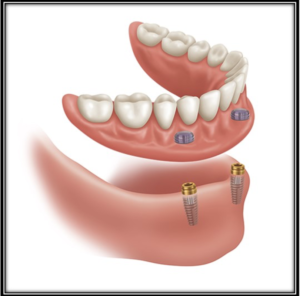
2 Locators and an Over-Denture
Restoring Stability with Implants for Long-Time Denture Wearers
- Even people who have worn full lower dentures for many years, can, in most cases, have implants added later to stabilise their lower denture.
- There are some limitations in those who can have these implants placed in the lower jaw.
- Some factors that can prevent the placement include extreme shrinkage, or atrophy, of the lower jaw where insufficient bone is left to hold the implants, and some medical conditions.
- Some factors may influence the success of implants including smoking, diabetes, and osteoporosis.
Do we place the implants, at Future Dental?
No. But we work in conjunction with our Oral and Maxillofacial Surgeons, OMF Surgeons, who place the implants, and we later fit the Locators to the implants after a typical period of 12 weeks during which the Implants are fully integrated into your jawbone, and then adapt your denture to fit the Locators.
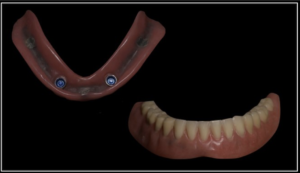
The Retentive Unit placed inside your lower denture to clip onto your Locators
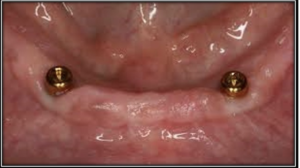
The Locators fitted to your Implants that grip the Retentive Unit inside your denture.
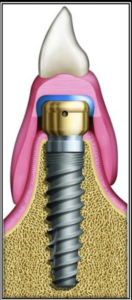
Your Implant, Locator, Retentive Unit, Unit Housing and your Lower Denture.
Why do we use the OMF Surgeon rather than doing the implants ourselves even though we are trained to do so?
There are a few general Dentists who rate themselves good enough to do these.
An OMF Surgeon being entrusted to this highly specialised procedure, gives you the highest probability that your Implants, and the success of your Locators will last a lifetime. In the hands of the OMF Surgeon, the success rate is typically 98% or even higher.
Are you limited to 2 lower implants?
No. A denture is removable if placed on 2 Locators (Over-Denture), a denture can be fixed in position, so it is not removable, except for routine maintenance every few years by Future Dental.
Are you limited to 2 Locators only in your Lower Jaw?
No. It is possible to have more implants placed and then more Locators can be used, and they can be used in the upper jaw as well.
The most economical solution for many is simply two lower implants.
Multiple Locators still allow for a very firm removable denture, but your denture can also be permanently fixed to a number of implants, so they are only removable by your dental practice for maintenance from time to time.
This technique is far more costly and typically equates to the cost of a small car, but it is a way of restoring full chewing function and preventing jawbone shrinkage.
This is typically done on 5 lower implants or, in the upper jaw, usually 6 implants.
Case Studies
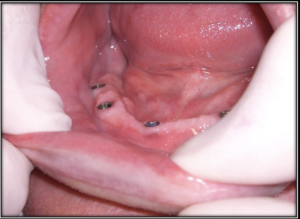
The Implants ready for a typical case of a Titanium Based Full Fixed Bridge/Denture on 5 Implants
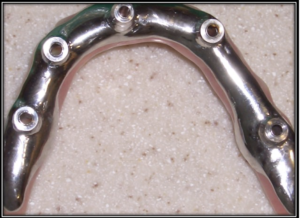
The underside of the Titanium Base holding the full Fixed Bridge/Denture for 5 Implants.
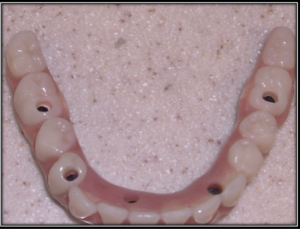
Top view of Full Lower Fixed Bridge/Denture for 5 Implants showing the screw holes.
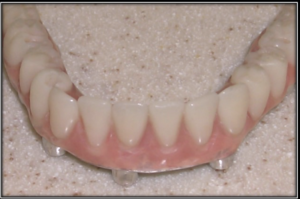
Front View showing the Titanium frame ready to screw down to 5 Implants.
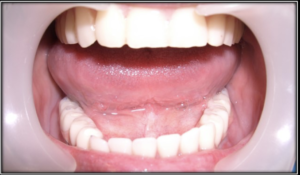
The Full Fixed Lower Bridge/Denture attached to 5 Implants in place.
We don’t recommend the “All on Four” technique
You may have heard of a technique called “All on Four”. With over 40 years of experience with full fixed dentures, and by working with highly experienced OMF Surgeons, we will not make an “All On Four’ because the loss of one implant leaves the patient with “None On Three”.
In other words, the unfortunate loss of just one implant through Periimplantitis, (gum disease around implants), renders your fixed “All On Four” totally unusable. If this event occurs on a fixed bridge done on 5 or 6 implants, there is still adequate anchorage for your fixed bridge/denture to function normally.
Why are “All On Fours” done?
It is typically done for competitive advantage between those general dentists or even just some less qualified specialist dentists who place implants who state it is cheaper or more convenient for the patient. Some even put them onto 4 implants just placed before the implants have had time to integrate to the jawbone (Immediate Loading). Again, we will never do that procedure.
Future Dental will not lower our standards just for a competitive edge over other dentists, by doing “All On Fours”, with or without Immediate Loading for any patient. After 48 years in the one practice, reputation and integrity is everything to us.
We hope this helps you to make long-term decisions if you are faced with losing your natural teeth.
Overdenture made on 2 implants and Locators Existing and New Dentures Cost
New Overdenture made on 2 implants and Locators Existing and New Dentures Cost Estimating
1. #661 abutment per fixture at $1295 each (2 = $2590)
2. #645 precision attachment for implant per fixture at $495 each (2 = $990)
3. #735 precision attachment in prosthesis per fixture at $495 each (2 = $990)
4. #743 MAY BE REQUIRED IF USING ORIGINAL DENTURE?? ($495)
5. Depending on whether locators
fitted directly intra-orally or based on an impression and
dental laboratory attaching female components in denture.
6. #665 If new un-reinforced denture is made ($2500)
7. #667 If metal reinforced denture is made ($3275)
Retro-fitting to original denture previously made
8. #661 abutment per fixture at $1295 each (2 =$2590)
9. #645 precision attachment for implant per fixture at $495 each (2 = $990)
10. #735 precision attachment in prosthesis per fixture at $495 each (2 = $990)
11. #743 Depending on whether locators ($495 or $795)
fitted directly intra-orally or based on an impression and
dental laboratory attaching female components in denture will cost extra.
Dr Bob Gibbins, BDSc HONS, Senior Consultant.
FUTURE DENTAL.


